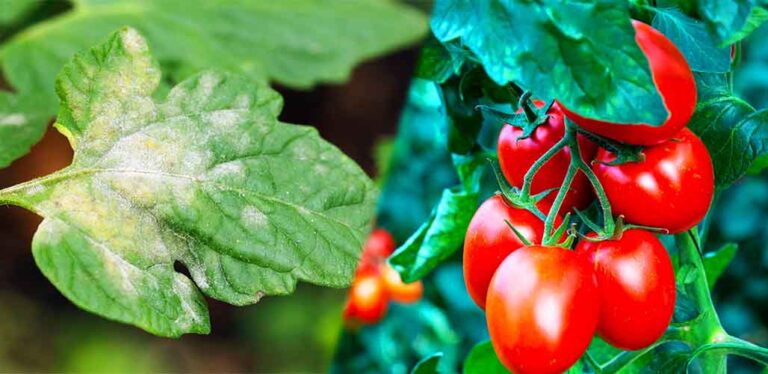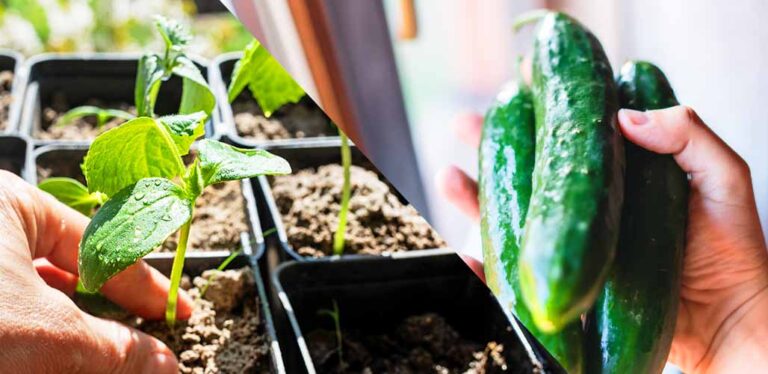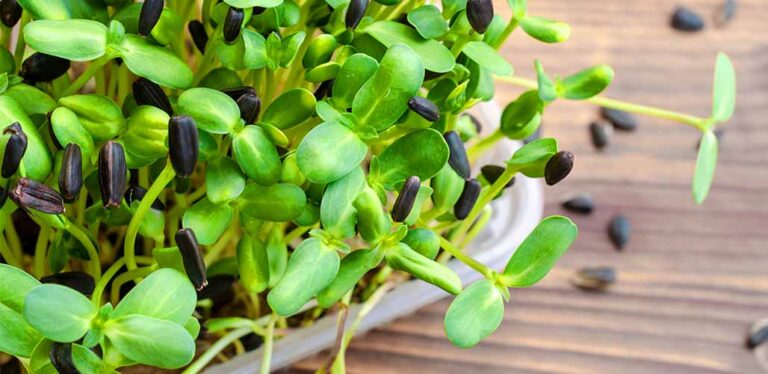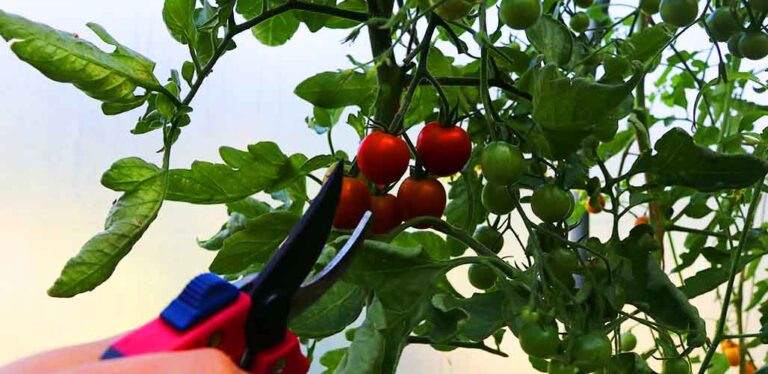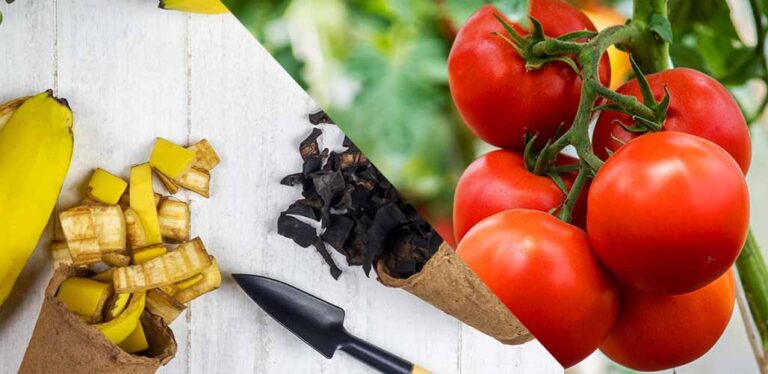How You Can Enjoy The Benefits Of Radish Sprouts
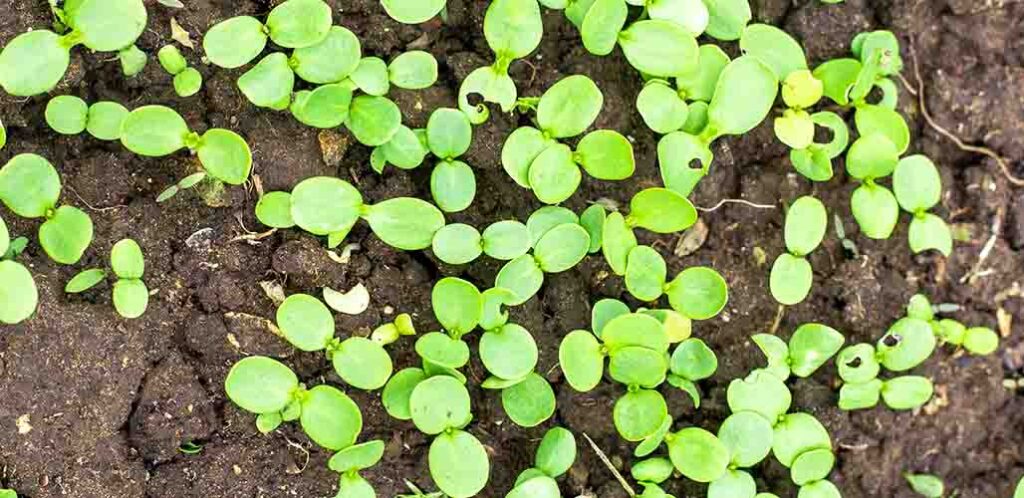
Rather than waiting weeks for radish seeds to grow into, well, radishes, lots of people (including me) are enjoying their nutrient-dense and flavor-packed sprouts in all kinds of dishes instead. I love how quickly this grow your own crop is ready to harvest – sometimes in less than a week. And I adore how versatile they are in meals, and how pretty their brightly-colored stems look on my plate. But long before they became fashionable in the rest of the world, they were already a staple of many Asian cuisines and appreciated for their health boosting properties. So here’s how to enjoy the benefits of radish sprouts in the most delicious ways possible!
Contents
- What are radish sprouts?
- The benefits of radish sprouts
- How to enjoy the benefits of radish sprouts
- How to grow radish sprouts at home
- Delicious ways to enjoy radish sprouts
- A safety warning
What are radish sprouts?
Radish sprouts are the 5-7 day old seedlings of the radish plant. They consist of just a 2 or 3 inch stem, and two seed leaves, or cotyledons. They are subtly distinct from microgreens, in that they are harvested before they produce their first true leaves. But, if they were left to grow on in suitable conditions, they would produce normal foliage, and their tap root would eventually swell and turn into the peppery root vegetable we’re more familiar with. In their seedling state, radish sprouts’ flavor and nutritional goodness are super-condensed. So compared to radish roots, you only need a small amount of radish shoots to transform a meal, and deliver hearty nutritional hit. Plus, they go from dormant seed to ready-to-eat in just 5-7 days, resulting in almost instant growing gratification!
Types of radish sprout
All radishes and radish sprouts belong to the species Raphanus sativus. Within that species, growers have developed many different varieties, including varieties specifically well suited to cultivating sprouts. The most common varieties grown for radish sprouts are:
- Daikon. Daikon radish sprouts have been a staple of Asian cuisine for generations. They have crisp and crunchy white stems, and green seed leaves. Their flavor is relatively mild, but still distinctly peppery.
- China rose. China rose radish sprouts have pink stems and green leaves. They can make absolutely any dish look Instagram-worthy, and their punchy flavor is impressive too.
- Rambo. Rambo radish sprouts have light purple stems and dark red-purple leaves. They pack a strong spicy flavor, and their unique pigment is associated with extra health benefits.
The benefits of radish sprouts
It’s impossible to show an interest in radish shoots without noticing all the hype around their superfood status. Radish sprouts contain plant-based chemicals (also known as ‘phytochemicals’) that can benefit our health in greater concentrations than the root we traditionally wait to harvest. Research has indicated that radish sprouts contain compounds that can protect us against or alleviate the symptoms of:
- Eye problems including glaucoma and inflammation of the retina
- Neurological diseases
- High blood sugar in people with diabetes
- Heart disease
- Cancer
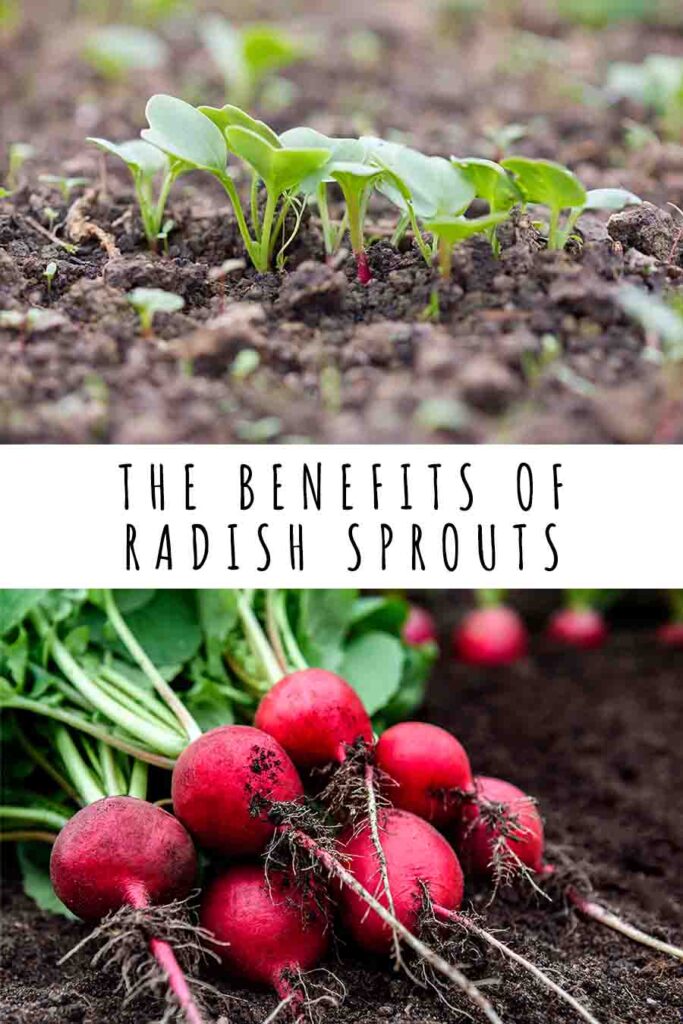
Radish sprouts are also a concentrated source of powerful antioxidant compounds that protect us from free radicals. Free radicals are unstable atoms produced as a normal waste product of our metabolism, but which are also present in cigarette smoke, pollution, and a variety of industrial chemicals, etc. Free radicals can damage our cells, causing premature aging and disease, but antioxidants protect us from that damage by binding and stabilizing them.
Pink and purple radish sprouts also contain high concentrations of anthocyanins . Anthocyanins are natural pigments which give them their color, but they are also efficient antioxidants, and research has linked them to positive impacts on visual and neurological health, and protection against heart disease, diabetes and cancer h.
How to enjoy the benefits of radish sprouts
So none of us have anything to lose by adding radish sprouts to our meals. Here’s how to make sure you enjoy maximum benefits:
- Go for pink or red varieties. The deeper the color, the more anthocyanins they contain (but the stronger the flavor too!)
- Eat them raw. Cooking destroys the compounds which do us the most good. They’re also far less appetizing cooked – raw sprouts are crunchy and fresh, cooked radish sprouts are limp and straggly.
- Keep harvested radish sprouts in the fridge. To preserve their freshness, and always use them before their expiry date, or within 14 days if you grew them yourself.
- Grow your own! It’s cheap, easy, and freshness is guaranteed.
How to grow radish sprouts at home
Growing your own radish sprouts is a fun experiment that everyone should try once. You can get radish seeds specifically for sprouting, which are sold in larger quantities than regular seed packets. But leftover seeds from traditional planting packets will work just as well, and it’s a good way to find out if radish sprouts are something you actually like.
The easiest way to sprout radish seeds for the first time with minimal expense is using an empty jelly or sauce jar from the store:
- Soak your seed in cool water for 4 hours, or overnight.
- Clean a jar in the dishwasher or using hot soapy water.
- Drain your seeds, rinse them in fresh cold water, and drain them again.
- Tip the seeds into the jar with the lid resting loosely on top, and put it somewhere bright, but not in direct sunlight.
- Rinse and drain the seeds with cool water every morning and evening – continuing even when sprouts start to form.
- The sprouts are ready to harvest when their stems are about 3 inches long, and their seed leaves have opened and turned green.
If you enjoy the results, you can eliminate the need for rinsing by growing your sprouts in a microgreens tray next time – these are available online and from nurseries where you can buy seed.
Delicious ways to enjoy radish sprouts
Radish sprouts’ peppery taste can be enjoyed in all the same ways you’d use a regular radish. They’re delicate, so it’s a good idea not to bash them about too much, or leave them sitting in a vinegary dressing for too long before serving. Here are my favorite ways of using (and using up) radish shoots:
- Add them to salads. They pair well with lean meats like chicken or turkey, oily fish like salmon and mackerel, juicy fruits like watermelon and orange, and mild cheeses like feta and goats cheese.
- Stir them into Asian-inspired slaws with a toasted sesame oil and rice vinegar dressing.
- Use them to adorn your avocado on toast at breakfast or brunch.
- Garnish stir frys or other Asian dishes. Their crunchy texture is the perfect foil for sticky glazes on ribs and other meats.
- Roll daikon radish sprouts into sushi, or balance them on top of sashimi for an authentic finishing touch.
- Put them in sandwiches – egg and radish sprout is the new egg and cress!
- Use up leftover sprouts in smoothies instead of ginger or spinach, for an unusual kick.
Are radish sprouts safe?
Finally, radish sprouts haven’t just been studied to prove or disprove their health benefits. In the 1990s, some serious E. coli outbreaks in Japan were linked to radish sprout served at local schools. So their potential as a source of food poisoning has also been closely examined. Fortunately, the conclusions of this are that the E. coli was absorbed by the radish seed from contaminated water, and radish shoots are completely safe to eat when they are grown in clean water.
So, be careful to maintain strict hygiene standards when you grow your shoots, and store them in the fridge after harvesting. Use them up as soon as possible, and always within 14 days.
How to enjoy the benefits of radish sprouts – summary
Radish sprouts are quick and easy to grow, and have flavor and health benefits completely out of proportion to how much effort they took to grow. They are super versatile too – I add them to everything from sandwiches to salads and easily devour a trayful in just a couple of days. If you’ve never grown anything to eat before, there’s no excuse not to give these a try now! Let us know how you get on in the comments box down below.

